In this section we hope to debunk any myths about composting as we build up a series of articles from John and Sandy Young (our very own Master Composters) and seek to discuss the subject in greater depth, hopefully taking away any of the worry or confusion you may have on this very straightforward and highly productive process.
Compost Corner – Autumn 2020
Autumn is upon us and it’s time to give some attention to our compost heaps. It’s when we look at each heap and see whether we have some dark matter which is usable compost. If you have Dahlik type, check in the inspection hatch, if it’s good to use. Lift the bin up, move to one side, use the top material not ready into the bin and harvest the rest. If you are using 1m cube pallets. This is a good time to make another one alongside, then start turning the others with material still working into it. It will recharge that it/them for over wintering. Then continue and when you come to lovely dark matter ie compost it’s time to harvest. If you now have some empty beds/ground , run a hoe through it and cover with Compost , which will act as a mulch keeping the weeds down and giving your soil nourishment. If you still have some planting to do eg. Garlic, onions, a brassica. Just plant through it.
Bonfires and incinerators. This year we have had enquiries about them from new members. As far as I am concerned we do not use either, all so called waste material is composted one way or another or incorporated around our plot. This can be of use to to wild life . Even Cooch grass and Bind weed these are put in a waste bin and covered with water. After a month there is no chance of re germination, put it in the bottom of a compost heap. Nothing is wasted. It will all go back on your ground and feed your vegetables.
Compost Corner Summer 2020 – COVID-19 Lockdown
2020 is half way through and it’s like no other year I have ever known. However with all the new rules and regulations we have been so pleased to have an allotment. This has been our exercise and good feel activity. Despite the very wet start of the year and following very dry period we have managed to continue to eat well off it.
With regard to composting, I am glad I make so much as I have managed to further my No Dig experiment now in year 3. This year I ordered a trailer load of farm cattle manure which I spread on 50 % of my beds leaving on the top for the worms to take down. Then on 25 % beds I spread sheets of thick cardboard and then covered with a layer of my compost. The other 25% was just a thick layer of my compost.
Come spring and planting time it was a good time compare. We had moved from a wet period to a very dry one. The manure had not broken down as I would have liked and dried into lumps. But I managed to plant our potatoes in those beds. The best weed supressed and best tilth was the cardboard/compost with the all compost a close second despite the hard ground.
Up to now we have planted out runner and climbing french beans, carrots, parsnips, sweetcorn and some brassicas and butternut squashes. Its surprising once you had dug the hole to place the plants there was moisture under the surface.
This year Severn Trent has asked us all to be careful on the water we use. Not to use hoses or sprinklers and to use watering cans. Which is just aswell we have fitted cattle trough type units around the site.
The only times I use water is when I puddle in at planting time. Then when the crop show flower or the pods are swelling in the case of peas and beans. And this only done early morning or better in the evening. This is always at the roots and never over the leaves. The worse is to waste with evaporation.
For the second half of the year I hope the environment will improve and we have weather more suitable for us gardeners and that our crops will thrive and we can look forward to eating well. Then we can look to filling our compost heaps again and harvesting ready compost to continue the cycle.
John Young (Chair)
Compost Corner Spring 2020 update
Its Spring around the corner. However the ground is very wet and even the weeds are not showing, so it must be too cold to think sowing. Although if you have raised beds or can put a wide plank across your plot you could plant some onion sets. But a job you could be doing, is sort out your compost bins. Depending on what you use follow the following suggestions.
1) Black dalek type, Look in the inspection hole at the bottom. If there is nice black compost. Then get ready to harvest. Lift off the bin and place close by. Put the top material that is not ready yet into the bin as a starter as it will have bugs and bacteria in it . Then use the black material either spread on your plot or left to one side to deal with later.
2) Pallet Bin type, check the compost and if it’s ready use, use it direct on your plots or easily available to when you are ready. If not just move it into the next empty bin. This will charge it up to face the coming warmer weather for harvesting in the autumn.
In the Autumn Compost Corner I mentioned Leaf Mould. If you have been collecting for a few years this material may be ready for using directly on you plot as Leaf Mould is very good for moisture retention through out the growing season. If you only started recently you could give a turn to give an assistance in the composting process.
Have a good composting year.
John Young
An Introduction to Composting by John Young (Master Composter)
Composting makes the world go round. It recycles the nutrients that plants (and Animals) grow, feeds the bugs that keeps the soil healthy and is sustainable, a low cost way of dealing with rubbish that rots. And it can be fun too.
Thinking composting should be on our minds from the first day we take on an allotment. It starts when you clear your site and when you have waste material from your crop that you do not wish to eat. All that grows has a use and the shortest distance for carrying this material is within your plot. If you take it any where else you will most probably be taking away valuable top soil with nutrients and organisms that your next crop will rely upon.
What to make Compost in. There are a number of options but make it simple and to suit you and to make it manageable. Not in a great untidy heap like my grandfather did. It made good compost over time but it was difficult to find it. Geoff Hamilton came up with a system which was a series of wood boxes each measuring 1m x 1m x 1m. A cubic meter allows the material to heat up and if you turn it from one box to the next a couple of times a year. You should have good compost to put on your plot. This could be ready in 12 to 18 months. Depending on the material you put in. It’s worth waiting for. The box can be made out of discarded wood or the favourite is to use used Pallets. 4 pallets to make 1 box and 7 to make it 2 and so on.
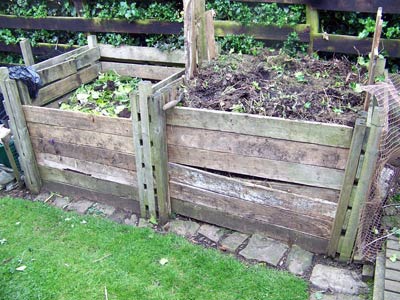
An alternative is the Black (Dalek) which is more for the household but it is a good starter. These are available through Warwickshire County Council at a subsidised price. The suitable size is a 330 litre. You do not turn the material, just feed it and occasionally use a fork in the top so it does not compact.
No, not what we had in mind. Much more like it.
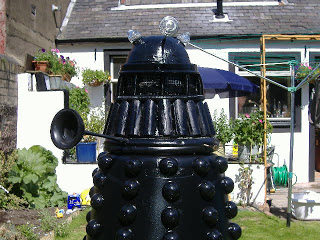
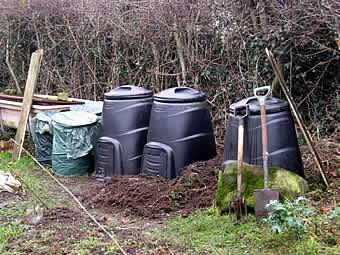
Where to place the compost bins.There is a logic to place them in the centre of your plots but this may not be best for your garden plan or the available area. We have placed ours on a site at the bottom of our plots as it was convenient for loading, harvesting and distributing the compost. They should be placed directly on to the bare ground so that the Brandling worms and the bugs (which are part of the composting process) gain easy access the from the soil.
What you put into the bins.Try to get a mix of Greens (which composts quickly) only this gives a wet compost and Browns slower to rot (high fibre material) only this it will be too dry. The mix is ideal.
Greens: Vegetable peelings/scraps, Fruit scraps, Annual weeds (less seed heads) spent bedding plants, comfrey, nettles, grass cuttings etc.
Browns: crushed paper, garden pruning, straw, corn cob & stalks, manure from herbivores .
What not to put into the bin; Cooked food scraps, dog or cat faeces , pernicious weed roots (these can be processed by placing in a container of water for at least a month )
What benefits does compost have: It improves the soil, whatever type you have. It lightens a clay soil and gives more humus to a light one. It keeps the soil moist, so there is less need for watering. Compost fed soils tend to grow healthier crops and more resistance to pests and diseases.
When to get started and follow up information. The time to get started or check your bins is now. We will follow up with when and what to do in early Spring.
John & Sandy (plot 9) as Master Composters for Warwickshire are available for further advice either on your plot or by e-mail.
Have a good composting and growing
Compost Corner Update Winter 2018/2019
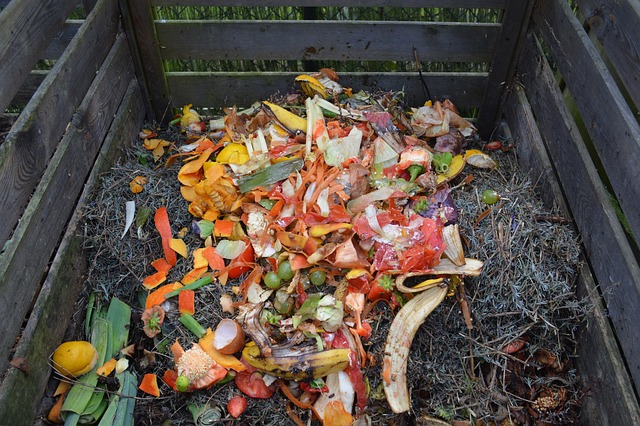
Winter is now with us. This is an important time of the year for gardeners and their compost bins. Checking the state of the compost in containers. If it’s dark and well rotted it’s time to harvest it and lay it over cleared ground as a mulch. This has the advantage or suppressing weeds and adding humus to the soil. Next if it still needs more time, physically move it into another bins next door. This will give the heap the more oxygen and put into a better position for using in the spring.
This should give you more space for putting the waste material that comes off the plot that has been all the part of enjoying a good harvest. Remember most waste can go in but any stalks like sweet corn, Brussels etc using secateurs or suitable cutters. Reducing the stalks to no more than 10 cm and in some cases hit them with a hammer to flatten them which helps the rotting process.
Leaf mould is also a valuable mulching material and this is the time of the year to collect it. It can take 3 to 5 years to rot down , depending on the tree/leaf type. However its well worth the wait. Over the last few years I have shortened the time by putting the leaves into builders bag with holes punched in the bottom with a fork. It works because the outside does not dry out like in a wired area. You can find these bags discarded in many a skip.
Good composting, John Young
Composting Bin Update 12th February 2018
Further to our introductory piece we have been making best use of this early season and have been refurbishing our compost bins.
Still using some of our original pallets from 2001 and adding new ones where necessary we have extended our pallet bins from 3 to 4. See the photos below.

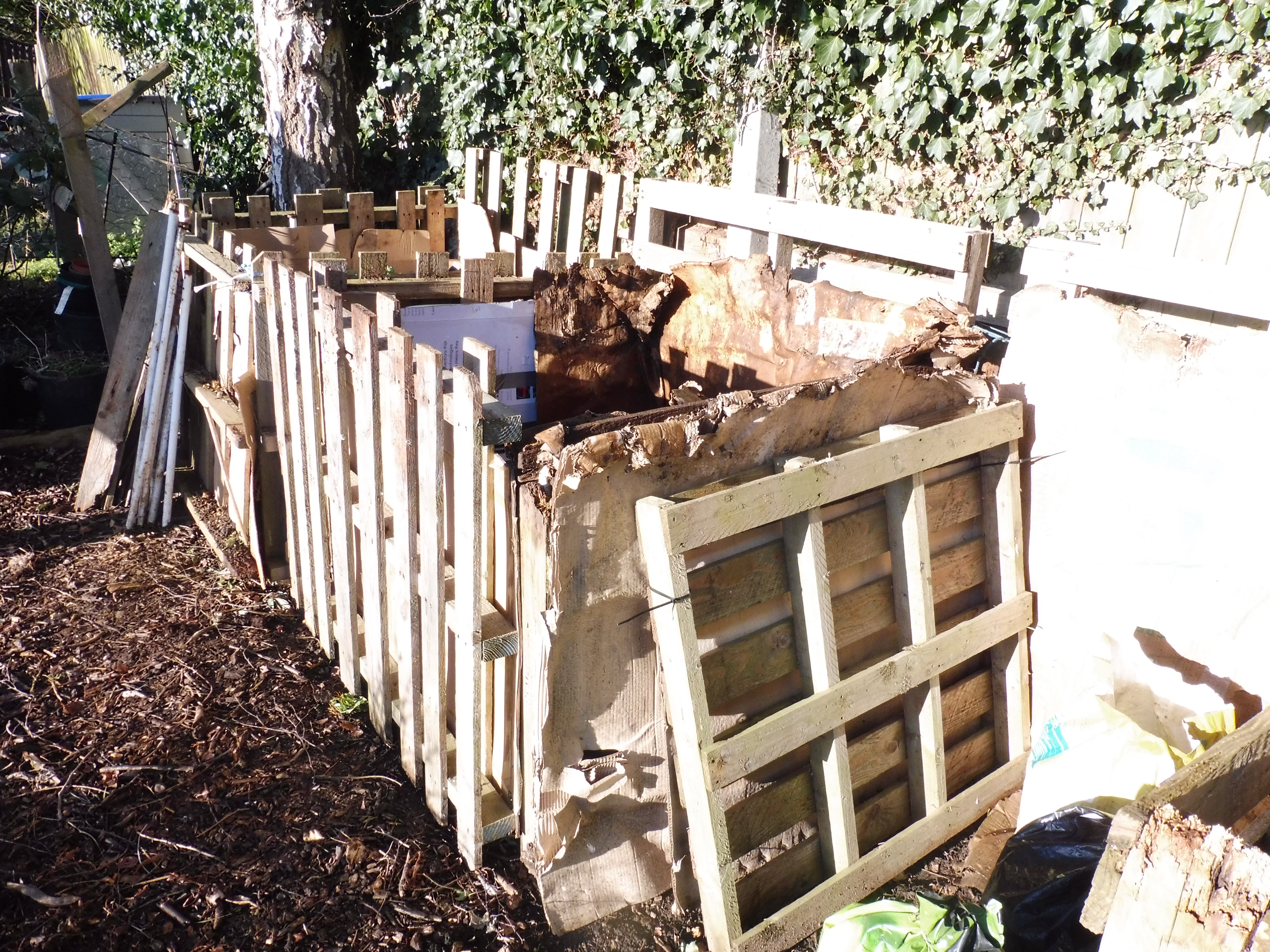
Sandy has been stapling on some cardboard to the sides, you can also use tacks or staples, and anything to hold it against the pallet. This stops the material falling out and helps to retain the heat that the compost will create. The cardboard over time will rot down as its one of the browns.
There is plenty of heavy duty cardboard available these days with all the packaging people receive in the goods we purchase, it is a good re-use and helps you get even more from your compost system.
John & Sandy. Plot 9
